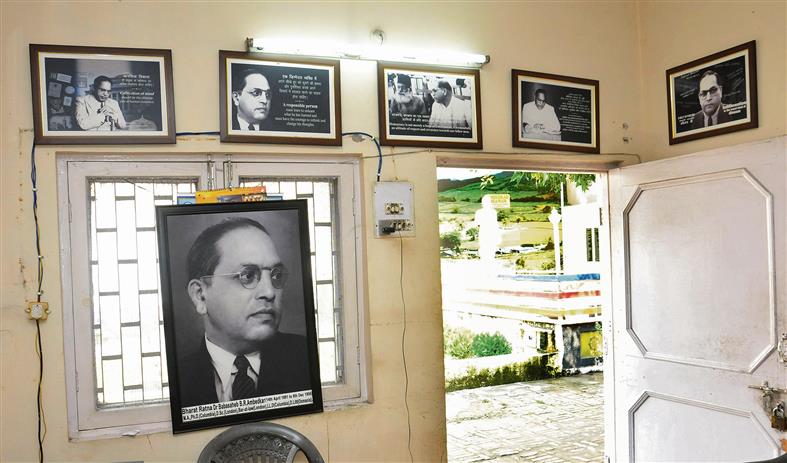Dr Ambedkar's objections and suggestions raised in 1955 were accepted in 1977 when the Indira Gandhi government converted the Untouchability Offences Act into the Protection of Civil Rights Act, 1977. file photo: the tribune
Book Title: Caste Pride: Battles for Equality in Hindu India
Author: Manoj Mitta
Raja Sekhar Vundru
Here is a rare book that is tracing untouchability’s demise. Hasn’t untouchability died yet? Or are we here to sustain untouchability and its manifold manifestations? Manoj Mitta’s book is one of a kind. Dr BR Ambedkar, through his works, had opened the eyes of the world to untouchability, the reasons for it and how and why the Hindu social order treats its own men the way it does. If some of us thought that after untouchability was abolished under the Constitution of 1950, it has disappeared, we are under an illusion. Mitta’s book is a stark reminder that there is a lot more to do.
The book tells the struggle through legislative bodies, social movements and court-room interjections, the Victorian morals, the Hindu-edified social divisions, how Ambedkar and Mahatma Gandhi and lesser-known fighters like Vittalbhai Patel fought for emancipation, reform and equality. He describes how sanatanists like Madan Mohan Malviya and scores like him couldn’t grapple with the fast-changing India, then.

Mitta’s book also expands the understanding of early 20th century where the law which sought equality and Hindu social code, clashed in instances when upper castes felt offended if lower-caste women covered their breasts (Travancore state); and how Rajputs (Rajasthan) were offended if their women were stopped from committing sati on the pyre of their dead husbands. Upper castes were offended that untouchables would make temple entry and looked for ways to prevent untouchables from roaming in streets and drink water from any public-watering hole. Here we see caste pride at play.
The second part of the book is all about how the law, the political game, Parliament and societal pressure worked both ways. Firstly, in expanding the legal punishment for untouchability and its related offences, and then, after all of it, how the killings, massacres and rapes wouldn’t stop.
Mitta conveniently starts the book with the advent of the British, the way they created and evolved law, which in form and text is in today’s Constitution and legal framework. Like a true legal expert, Mitta explains about a law or a resolution being objected to by the male lawmakers. He goes into meticulous detail and gives a deep insight into the minds of men in the 19th and 20th centuries, while they decided on the rights of women and untouchables.
The author starts the milestones with a 1795 incident where the East India Company exempted the Banaras Brahmins from the death penalty in case of a crime, and ends with the 2019 ruling of the Supreme Court upholding life sentences for the eight accused in the Khairlanji atrocity. The book details how Gandhi turned the national movement into a social programme and the entire Gandhi-driven temple entry legalisation debate is well chronicled.
Post-Independence, Mitta takes the reader through the debates in the Constituent Assembly on abolition of untouchability, insertion of Article 17 and how it took five years to criminalise abolition through the Untouchability Offences Bill in 1955. The Bill also subsumed all the temple entry legislations of the national movement. We have the rare appearance of Ambedkar in the Rajya Sabha (he resigned as the Law Minister in 1951) debating the Bill. His objections and the suggestions raised in 1955 were accepted in 1977. Indira Gandhi’s government, after seeing the failure of the 1955 Act, converted the Untouchability Offences Act into the Protection of Civil Rights Act, 1977, and included Ambedkar’s 1955 suggestions.
The author lists the way courts dealt with and let off killers in horrifying inhuman massacres of Dalits in Kilvenmani, Shankarbhiga, Belchi, Bathani Thola, Tsundur, Jhajjar and finally, Khairlanji. He has missed institutional deaths like Rohith Vemula’s. The book leaves us pondering over the efficacy of implementation of the Scheduled Caste and Scheduled Tribes (Prevention of Atrocities) Act, 1989, and its newer version of 2016 to eliminate the manifestations of untouchability.
The book is a long journey of Hindu India’s struggles to bring in equality in a deeply caste-entrenched and divided society. It takes us through the differential punishment reserved for lower castes and the discrimination and oppression of women, Hindu Code Bill and the rights of women, and how caste has played a major role in the courtrooms on aspects of discrimination, inheritance and internecine rivalry between the varnas.
What Manoj Mitta undertakes in his magnum opus is of the play of the Hindu caste system within the legal framework and how the basic tenets of equality, fraternity and liberty have been in conflict with the Hindu social order. It will be a handbook for lawyers, historians, social activists and a must-read for all those who believe in creating an equitable society of India for both women and Dalits.














